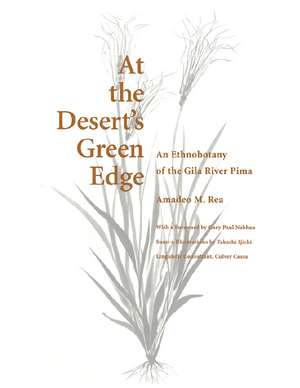At the Desert's Green Edge: An Ethnobotany of the Gila River Pima
Autor Amadeo M. Rea Cuvânt înainte de Gary Paul Nabhan Ilustrat de Takashi Ijichi Contribuţii de Culver Cassaen Limba Engleză Paperback – iun 2016
Winner of the Society for Economic Botany’s Klinger Book Award
The Akimel O'odham, or Pima Indians, of the northern Sonoran Desert continue to make their home along Arizona's Gila River despite the alarming degradation of their habitat that has occurred over the past century. The oldest living Pimas can recall a lush riparian ecosystem and still recite more than two hundred names for plants in their environment, but they are the last generation who grew up subsisting on cultivated native crops or wild-foraged plants. Ethnobiologist Amadeo M. Rea has written the first complete ethnobotany of the Gila River Pima and has done so from the perspective of the Pimas themselves.
At the Desert's Green Edge weaves the Pima view of the plants found in their environment with memories of their own history and culture, creating a monumental testament to their traditions and way of life. Rea first discusses the Piman people, environment, and language, then proceeds to share their botanical knowledge in entries for 240 plants that systematically cover information on economic botany, folk taxonomy, and linguistics. The entries are organized according to Pima life-form categories such as plants growing in water, eaten greens, and planted fruit trees. All are anecdotal, conveying the author's long personal involvement with the Pimas, whether teaching in their schools or learning from them in conversations and interviews.
At the Desert's Green Edge is an archive of otherwise unavailable plant lore that will become a benchmark for botanists and anthropologists. Enhanced by more than one hundred brush paintings of plants, it is written to be equally useful to nonspecialists so that the Pimas themselves can turn to it as a resource regarding their former lifeways. More than an encyclopedia of facts, it is the Pimas' own story, a witness to a changing way of life in the Sonoran Desert.
The Akimel O'odham, or Pima Indians, of the northern Sonoran Desert continue to make their home along Arizona's Gila River despite the alarming degradation of their habitat that has occurred over the past century. The oldest living Pimas can recall a lush riparian ecosystem and still recite more than two hundred names for plants in their environment, but they are the last generation who grew up subsisting on cultivated native crops or wild-foraged plants. Ethnobiologist Amadeo M. Rea has written the first complete ethnobotany of the Gila River Pima and has done so from the perspective of the Pimas themselves.
At the Desert's Green Edge weaves the Pima view of the plants found in their environment with memories of their own history and culture, creating a monumental testament to their traditions and way of life. Rea first discusses the Piman people, environment, and language, then proceeds to share their botanical knowledge in entries for 240 plants that systematically cover information on economic botany, folk taxonomy, and linguistics. The entries are organized according to Pima life-form categories such as plants growing in water, eaten greens, and planted fruit trees. All are anecdotal, conveying the author's long personal involvement with the Pimas, whether teaching in their schools or learning from them in conversations and interviews.
At the Desert's Green Edge is an archive of otherwise unavailable plant lore that will become a benchmark for botanists and anthropologists. Enhanced by more than one hundred brush paintings of plants, it is written to be equally useful to nonspecialists so that the Pimas themselves can turn to it as a resource regarding their former lifeways. More than an encyclopedia of facts, it is the Pimas' own story, a witness to a changing way of life in the Sonoran Desert.
Preț: 354.93 lei
Preț vechi: 474.13 lei
-25% Nou
Puncte Express: 532
Preț estimativ în valută:
67.92€ • 72.63$ • 56.63£
67.92€ • 72.63$ • 56.63£
Carte indisponibilă temporar
Doresc să fiu notificat când acest titlu va fi disponibil:
Se trimite...
Preluare comenzi: 021 569.72.76
Specificații
ISBN-13: 9780816534296
ISBN-10: 0816534292
Pagini: 459
Ilustrații: 157 halftones, 12 tables
Dimensiuni: 216 x 279 x 36 mm
Greutate: 1.05 kg
Ediția:1
Editura: University of Arizona Press
Colecția University of Arizona Press
ISBN-10: 0816534292
Pagini: 459
Ilustrații: 157 halftones, 12 tables
Dimensiuni: 216 x 279 x 36 mm
Greutate: 1.05 kg
Ediția:1
Editura: University of Arizona Press
Colecția University of Arizona Press
Notă biografică
Amadeo M. Rea is an ethnobiologist and ornithologist who has conducted research on the Gila River Indian Reservation over a period of thirty years. He is also the author of Once a River: Bird Life and Habitat Changes on the Middle Gila
Recenzii
“Sets a new standard for ethnobotanical research.”—American Anthropologist
“Phenomenal . . . every person interested in American people and plants should use this book.”—Economic Botany
“The finest ethnobotanical book available . . . [a] masterpiece.”—Human Mosaic
“Phenomenal . . . every person interested in American people and plants should use this book.”—Economic Botany
“The finest ethnobotanical book available . . . [a] masterpiece.”—Human Mosaic
Descriere
Winner of the Society for Economic Botany’s Klinger Book Award, this is the first complete ethnobotany of the Gila River Pima, presented from the perspective of the Pimas themselves.
